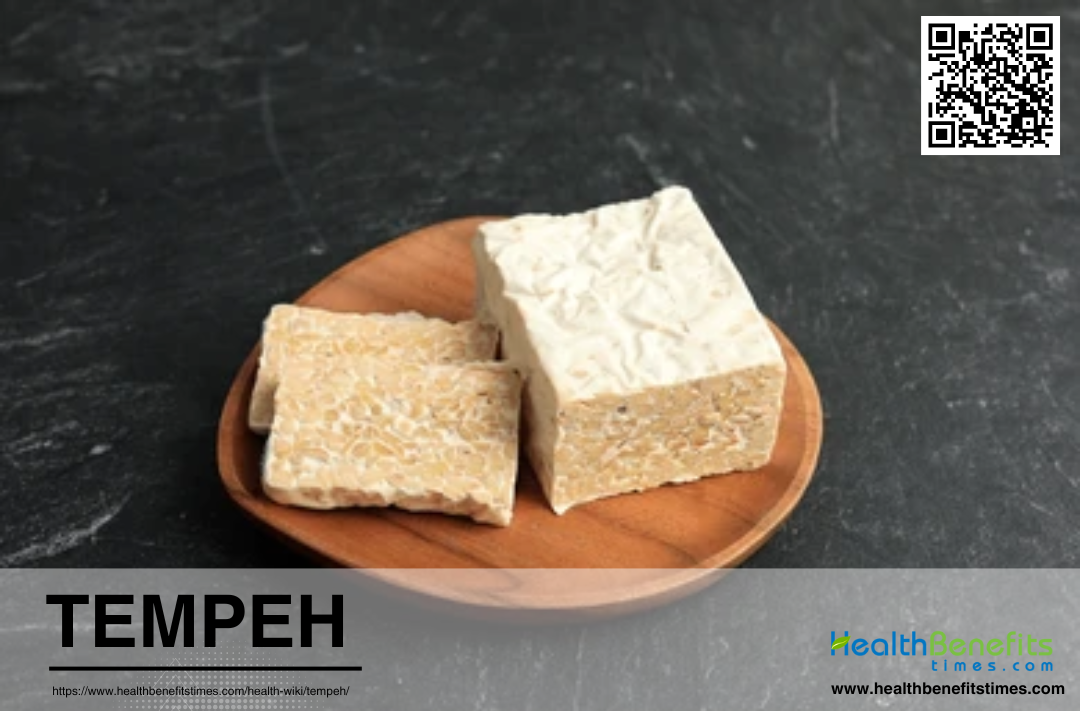Tempeh is a traditional Indonesian food made from fermented soybeans. It is a compact, dense cake-like product that has a distinctive nutty flavor and firm texture. The fermentation process involves inoculating boiled soybeans with a tempeh starter culture, which contains a mold species called Rhizopus. As the mold grows, it binds the soybeans together into a solid mass. Tempeh is highly nutritious, providing a good source of plant-based protein, fiber, and various vitamins and minerals. It is commonly used in Indonesian cuisine, either cooked in dishes or consumed as a meat alternative due to its high protein content and meaty texture when fried or baked.
Making Tempeh at Home
Making tempeh at home is a rewarding process that involves fermenting soybeans with a specific mold called Rhizopus oligosporus. Here is a step-by-step guide to help you make tempeh at home:
1. Soak the Soybeans: Rinse the soybeans thoroughly. Soak them in plenty of water for at least 8-12 hours or overnight.
2. Dehull the Soybeans: After soaking, drain the soybeans. Rub the beans between your hands to remove the hulls. This step is optional but helps create a better texture. Rinse and repeat until most of the hulls are removed.
3. Cook the Soybeans: Place the dehulled soybeans in a pot and cover with water. Bring to a boil and then simmer for about 30 minutes until the beans are cooked but still firm. Drain the beans and let them cool.
4. Dry the Soybeans: Spread the cooked soybeans on a clean kitchen towel to dry them. They should be dry to the touch to prevent unwanted bacteria growth.
5. Inoculate the Soybeans: Place the dried soybeans in a mixing bowl. Add 1 tablespoon of vinegar to the beans (optional, helps to lower the pH). Sprinkle the tempeh starter over the beans and mix thoroughly to ensure even distribution.
6. Pack the Soybeans: Take a plastic zip-lock bag or banana leaves and poke small holes throughout to allow air circulation. Pack the inoculated soybeans into the bag or wrap them in the leaves, pressing them into a flat, even layer about 1 inch thick.
7. Incubate the Tempeh: Place the packed soybeans in an incubator or a warm place with a stable temperature of 86°F to 91°F (30°C to 33°C). Let it ferment for 24-48 hours. You will notice white mycelium growing and binding the beans together.
8. Check the Tempeh: After 24 hours, check the tempeh. It should have a firm texture and be covered with white mycelium. If it is not fully fermented, let it continue for another 12-24 hours.
9. Harvest and Store: Once fully fermented, remove the tempeh from the incubator. You can store it in the refrigerator for up to a week or freeze it for longer storage.
Nutritional value of tempeh
It is an excellent source of plant-based protein, making it a popular choice among vegetarians and vegans. Additionally, tempeh is rich in essential vitamins and minerals, and its fermentation process enhances its digestibility and probiotic content. Here’s a breakdown of the nutritional value of tempeh:
1. Protein: Tempeh is a rich source of complete protein, containing all essential amino acids necessary for human health. A typical serving of 100 grams of tempeh provides about 18 to 20 grams of protein.
2. Fiber: Rich in dietary fiber, tempeh promotes digestive health and can help with maintaining a healthy gut. A 100-gram serving contains about 5 to 7 grams of fiber.
3. Vitamins: Tempeh is a good source of B vitamins, particularly B2 (riboflavin), B3 (niacin), B6, and B12, which are essential for energy metabolism and nervous system health.
4. Minerals: It contains a variety of minerals, including calcium, magnesium, phosphorus, iron, and zinc, making it beneficial for bone health, energy production, and immune system function.
5. Fats: Tempeh contains healthy polyunsaturated and monounsaturated fats, including omega-3 fatty acids, which are important for cardiovascular health.
6. Isoflavones: As a soy product, tempeh is rich in isoflavones, which are phytoestrogens that may offer health benefits such as reducing the risk of heart disease, osteoporosis, and certain forms of cancer.
Health benefits of consuming tempeh
Its rich nutrient profile supports various aspects of health, from improving digestion to enhancing bone strength. Here are some key health benefits of consuming tempeh:
1. High in Protein
Tempeh is a fermented soybean product that serves as an excellent source of plant-based protein. It is highly digestible and can be a substitute for animal protein, making it a valuable food for combating malnutrition in regions with limited access to animal protein sources. The fermentation process enhances the protein content and bioavailability, making tempeh a nutritious option for those following plant-based diets.
2. Reduces Inflammation
Studies have shown that consuming tempeh can reduce levels of high sensitivity C-reactive protein (hsCRP), a marker of inflammation, in obese women. This reduction in inflammation can help lower the risk of chronic diseases associated with obesity and inflammation.
3. Improves Digestive Health
The fermentation process increases the content of soluble fibers and beneficial bacteria like Bifidobacterium and Akkermansia muciniphila, which are known to improve gut health and boost the immune system. Regular consumption of tempeh can thus support a healthy digestive system.
4. Promotes Bone Health
Isoflavones in tempeh, such as daidzein and genistein, have been linked to improved bone health. These compounds mimic estrogen and can help maintain bone density, particularly in postmenopausal women. Studies have shown that soy food consumption, including tempeh, can improve bone mineral content, making it beneficial for bone health.
5. Lowers Cholesterol Levels
In a study involving hypercholesterolemic subjects, daily consumption of tempeh significantly reduced total cholesterol and LDL cholesterol levels 3. Another study on Wistar-male rats confirmed that tempeh consumption could lower cholesterol levels, thereby reducing the risk of atherosclerosis and coronary heart disease.
6. Supports Weight Management
A study on hypercholesterolemic subjects found that tempeh consumption led to significant reductions in body weight and waist circumference. The presence of beneficial bacteria in tempeh also supports metabolic health, further aiding in weight management.
7. Promotes Cardiovascular Health
The cholesterol-lowering and anti-inflammatory properties of tempeh contribute to cardiovascular health. By reducing total and LDL cholesterol levels and lowering inflammation markers like hsCRP, tempeh can help prevent cardiovascular diseases. The presence of isoflavones also supports heart health by improving lipid profiles and reducing the risk of atherosclerosis.
8. Prevent Certain Cancers
Isoflavones in tempeh have been associated with a reduced risk of certain cancers, particularly breast cancer. High soy food consumption, including tempeh, has been linked to lower breast cancer risk in women. The anticarcinogenic properties of isoflavones, along with the presence of antioxidants in tempeh, contribute to its potential in cancer prevention.
9. Strengthens Gut Health
Studies have shown that tempeh increases the populations of Bifidobacterium and Akkermansia muciniphila, which are crucial for maintaining a healthy gut environment. This improvement in gut health can lead to better overall health and immune function.
Culinary Uses of Tempeh
Tempeh is a versatile ingredient that can be incorporated into a wide range of dishes, making it a favorite among vegetarians and vegans. Its firm texture and nutty flavor allow it to absorb marinades well and complement various cuisines. Here are some popular culinary uses of tempeh:
1. Tempeh Bacon
It is typically made by marinating thin slices of tempeh in a mixture of soy sauce, maple syrup, liquid smoke, and spices before pan-frying or baking until crispy. This preparation method not only enhances the taste but also retains the nutritional benefits of tempeh, such as its high protein content and essential vitamins. Tempeh bacon is a versatile ingredient that can be used in sandwiches, salads, or as a breakfast side, making it a favorite among vegetarians and vegans.
2. Tempeh Crumble
To prepare, tempeh is crumbled into small pieces and sautéed with onions, garlic, and spices until it achieves a browned, crumbly texture. This method of preparation allows tempeh to absorb flavors well, making it a flavorful addition to any dish. The fermentation process of tempeh enhances its digestibility and nutritional profile, providing a good source of protein, vitamins, and minerals. Tempeh crumble is an excellent option for those looking to reduce meat consumption while maintaining a nutrient-rich diet.
3. Tempeh Curry
To make tempeh curry, tempeh is typically cubed and cooked with a blend of spices such as turmeric, cumin, coriander, and coconut milk. This dish not only offers a burst of flavors but also provides a balanced meal with protein, vitamins, and minerals. The fermentation process of tempeh enhances its nutritional value, making it a healthy addition to the curry. Tempeh curry can be served with rice or naan, making it a satisfying and wholesome meal.
4. Deep-Fried Tempeh
Deep-fried tempeh is a popular snack or side dish that offers a crispy texture and rich flavor. To prepare, tempeh is cut into bite-sized pieces, marinated, and then deep-fried until golden brown. This cooking method enhances the natural nutty flavor of tempeh while providing a satisfying crunch. Despite the frying process, tempeh retains its nutritional benefits, including high protein content and essential vitamins. Deep-fried tempeh can be enjoyed on its own, with dipping sauces, or as a topping for salads and bowls, making it a versatile and tasty option.
5. Steamed Tempeh
Steamed tempeh is a simple and healthy way to enjoy this nutritious food. Steaming tempeh helps to retain its natural flavors and nutritional benefits, including its high protein content and essential vitamins and minerals. To prepare, tempeh is cut into desired shapes and steamed for about 10-15 minutes. This method of cooking makes tempeh more digestible and enhances its texture, making it a great addition to salads, stir-fries, or as a side dish. Steamed tempeh can also be marinated and then grilled or baked for added flavor.
6. Marinated Tempeh
Marinated tempeh is a flavorful and versatile ingredient that can be used in a variety of dishes. To prepare, tempeh is cut into slices or cubes and marinated in a mixture of soy sauce, vinegar, oil, and spices for several hours or overnight. This process allows the tempeh to absorb the flavors of the marinade, enhancing its taste and making it a delicious addition to salads, sandwiches, and stir-fries. Marinated tempeh retains its nutritional benefits, including high protein content and essential vitamins, making it a healthy and tasty option for any meal.
7. Blackened Tempeh
Blackened tempeh is a bold and flavorful dish that involves coating tempeh in a blend of spices and then searing it until it forms a dark, crispy crust. The spice blend typically includes paprika, cayenne pepper, garlic powder, and thyme, which gives the tempeh a smoky and spicy flavor. This cooking method not only enhances the taste but also retains the nutritional benefits of tempeh, such as its high protein content and essential vitamins. Blackened tempeh can be served with rice, vegetables, or in sandwiches, making it a versatile and delicious option.
Side effects of Tempeh
While tempeh is a nutritious and beneficial food for many, it may cause side effects in some individuals. These can range from digestive issues to allergic reactions, particularly for those with soy allergies. Here are some potential side effects of consuming tempeh:
1. Allergic Reactions
Soybeans are a common allergen, and the fermentation process does not eliminate the allergenic proteins. Individuals with soy allergies may experience symptoms such as hives, itching, swelling, and in severe cases, anaphylaxis upon consuming tempeh. The fermentation process introduces various microorganisms, which might also contribute to allergic responses in sensitive individuals. Therefore, it is crucial for people with known soy allergies to avoid tempeh to prevent adverse reactions.
2. Gastrointestinal Issues
Consuming tempeh can lead to gastrointestinal issues in some individuals. The fermentation process produces various bioactive compounds and introduces microorganisms that can affect gut health. While tempeh is generally considered beneficial for the digestive system, it can cause bloating, gas, and diarrhea in some people, particularly those who are not accustomed to fermented foods. The high fiber content in tempeh can also contribute to these gastrointestinal symptoms. It is advisable for individuals with sensitive digestive systems to introduce tempeh gradually into their diet to monitor tolerance.
3. Medication Interference
Soy products, including tempeh, contain compounds known as isoflavones, which can mimic estrogen and potentially interfere with hormone levels. This can be particularly concerning for individuals taking thyroid medications, as soy isoflavones can inhibit the absorption of these medications, reducing their efficacy. It is recommended that individuals on thyroid medication consult with their healthcare provider before incorporating tempeh into their diet to avoid potential interactions.
4. Goitrogens
This can potentially lead to the development of goiter, an enlargement of the thyroid gland. While the fermentation process of tempeh reduces the levels of goitrogens compared to raw soybeans, they are not entirely eliminated. Individuals with thyroid conditions or those at risk of iodine deficiency should be cautious with their tempeh consumption. Regular monitoring of thyroid function and iodine levels is advisable for those who consume tempeh frequently.





